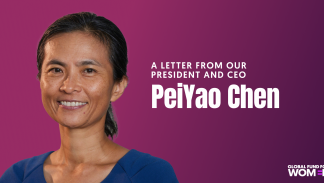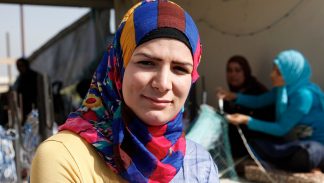What does it take to build transformative women’s leadership for social change?
Funding Leadership and Opportunities for Women (FLOW) is a fund initiated by the Dutch Foreign Ministry to strengthen the rights and opportunities for women and girls worldwide. From 2012 to 2015, Global Fund for Women received a $5.9 million dollar investment from this fund to support women led organizations in Asia and the Pacific. The grant focused on women’s efforts to eradicate violence against women and build peace; ensure equality of rights to economic and environmental security; and engage in the political and public life of their communities and countries. To date, this initiative entitled, “Transformative Leadership: Women at the Forefront of Systemic Change in Asia and the Pacific” (the Transformative Women’s Leadership Initiative, in short) has awarded grants to 139 women’s rights organizations in 26 countries.
Among the key accomplishments, grantees in the Transformative Women’s Leadership Initiative reported strengthening the leadership of over 60,000 individuals in 2014 alone. We wanted to learn more about the stories behind the numbers: What does transformative women’s leadership look like in the communities in which our grantees work? Why is this type of leadership important? What does it take for women’s groups to develop this type of leadership? And how can Global Fund for Women and other funders support it?
To explore these questions, a small team of Global Fund for Women staff embarked on a learning project to gather more in-depth data from grantee partners via interviews.
These were our key findings:
Key finding #1: Grantees of Global Fund for Women are helping to develop two types of transformative leadership among their beneficiaries/constituencies. The first type focuses on facilitating personal transformation (tier 1) and the second type focuses on developing social change agents (tier 2), with the latter building on the former.
Examples of personal transformation include but are not limited to: new and increased awareness of human rights; increased confidence and emergence of a new, positive self-concept, vision of one’s role in the community, and future; enhanced political intelligence (i.e. ability to analyze and develop political ideas); and strengthened capacity to claim and advocate for personal rights. Examples of traits that characterize social change agents include but are not limited to: strengthened capacity to provide and/or advocate for services and resources for other women; taking on leadership positions in the community, local or national level.
While most of the grantees interviewed for the learning project reported that their organizations promote both types of leadership, their approach to developing social change agents varies. Some see the development of social change agents as the natural next step after personal transformation has been achieved, yet they do not have specific strategies to facilitate such development. Others are very intentional in their strategies to help women become social change agents. They may use strategies to recruit, train, and provide on-going support to women leaders to engage in social change work. For example, one organization focuses on promoting women leaders to bring about social change by supporting them to first understand how their own circumstances as individual women relate to the patriarchal social structure, and how they can to solve their individual problems. Next they join with more experienced leaders to help other single women and participate in campaigns for their rights and the rights of others.
Key finding #2: The women who become social change agents (tier 2) have helped create change at the individual and systemic levels and in both formal and informal domains.
Examples of change created at multiple levels, based on the Change Matrix framework are listed below. Initial findings based on the small dataset are inconclusive but suggest that organizations that have specific strategies to develop social change agents are more likely to report greater social change outcomes than organizations that do not have specific strategies.
Social change created by tier 2 women leaders includes:
Increased awareness of individual women and girls (INDIVIDUAL / INFORMAL):
- Increased awareness of property rights and protection under current laws as a result of trainings held by a network of women local leaders
- Women leaders raised awareness of women on workers’ rights through the dissemination of a newsletter
Increased access to resources and services for women and girls (INDIVIDUAL / FORMAL)
- Women in the community are now able to receive services from the local government on livestock rearing. This is a result of women leaders becoming women’s affairs officers and implementing safety net programs for elderly and marginalized women.
- More women are accessing government services and joining local committees. In addition women leaders mobilized to hold the government accountable to budget allocated to women’s rights issues
Change in social norms (SYSTEMIC / INFORMAL)
- Shift in acknowledging the role of women in the community, and in particular, at the family level where more men are contributing to household chores so that the women are free to join collectives
- Changes in the way domestic workers are labeled by the community (from servant to domestic worker) and demonstrates increase in respect.
Change in policies (SYSTEMIC / FORMAL)
- The change in Family Law was the result of many women leaders mobilizing in support of the bill and the number of women candidates in election
- Women leaders actively participated in demanding the government pass pro-poor policies such as National Rural Employment Guarantee Act, Right to Information Act, and Right to Education Act.
Key finding #3: Not surprisingly, developing social change agents takes time. Grantees who have specific strategies to develop social change agents reported that it takes an average of three years and requires multiple strategies.
The most common strategies used by grantees to promote social change agents are skill building, awareness training, networking, supporting collective action, providing space for peer sharing, and linking women to additional opportunities. For example, one organization conducts awareness training on women’s rights and other legal mechanisms, international laws, CEDAW and gender policies to raise women leaders’ awareness. They also hold skills trainings to build women’s capacity in areas such as public speaking, writing and interacting with the media. One organization developed a 5-year model that moves women from initial training to change agent to community or political leader in a systematic method. They see value in establishing a 5 year cycle while also offering continued support to women leaders through networking and collaboration.
Key finding #4: Our data suggest that organizations that are intentional in promoting social change agents are more likely to promote young women leaders within the organization.
Our analysis shows that organizations that are intentional in developing social change agents are more likely to report equal decision-making power between generations or providing a clear growth path for young women in the organization. (Read three examples of how organizations promote young women’s leadership: Red Flag Women’s Movement; National Alliance of Women’s Human Rights Defenders Nepal; and Fiji Women’s Rights Movement.)
Key finding #5: Most grantees interviewed for this project highlighted the importance of long-term, unrestricted funding to support their work in promoting transformative women’s leadership. However, reality shows a different picture.
The majority of the grantees interviewed have highly restricted funding sources. While funding is a constant challenge for all of the organizations, some organizations articulated mitigating strategies to deal with the restrictions and lack of multi-year funding. Some relied on the commitment of staff members who were willing to work for reduced pay during the gap between funded projects. Some negotiated with funders to change the terms of the grants. While we applaud such efforts, it is clear that the lack of core funding to support organizational infrastructure not only creates an extra burden for grantees but also poses a threat to their sustainability.
These key findings also lead us to a number of recommendations:
Recommendation #1: Increase the proportion of multi-year grants in our overall grantmaking.
To support grantees to promote Transformative Women’s Leadership, we need to provide multiyear support because it takes an average of two to three years to help individual women become agents of change. Furthermore, leadership development is not a one-time activity of going from a “non-leader” to “leader.” Many groups stressed the need for long-term support to their leaders and the importance of networking among change agents to continue their work. Sustaining and continuing growth is also very necessary in transformational women’s leadership.
Recommendation #2: Create spaces, virtual or in-person, for grantees to share effective strategies in promoting young women’s leadership in the organizations.
This study highlights the importance of promoting young women leaders within the organization that promote transformational women’s leadership. Many of the groups were very articulate in the ways, both formal and informal, that they promote and value young women’s leadership. Promoting young women’s leadership has been a selection criteria in Global Fund for Women’s grantmaking and this finding confirmed our selection process. We suggest incorporating the rating scale we developed for this project into application review process. In addition, we saw this as an area where Global Fund for Women can support grantees to strengthen their organizational capacity. We suggest creating spaces, virtual or in-person, for grantees to share effective strategies in promoting young women’s leadership in the organizations.
Recommendation #3: Go beyond reporting the number of beneficiaries; invest staff time to follow up with grantees to explore the stories behind the numbers.
Based on our experience with this project, we are interested in applying this approach to facilitate internal learning. Key elements of this approach include (1) a core team that consists of LEI team and at least two additional staff members; (2) a ten month process from conceptualization to analysis; (3) focus on a topic Global Fund staff is interested in learning more about. In additional to internal learning, we also plan to share what we learned with external audiences more broadly.
Recommendation #4: Support further research to examine the link between an organization’s internal organizational qualities and the social change outcomes they create.
This learning project did not answer all of our questions and led us to new ones. In particular, we are interested in identifying key internal organizational qualities that are critical to creating social change outcomes. The information can help us improve our grantee selection criteria and provide more tailored support to help grantees strengthen their organizational capacity.


